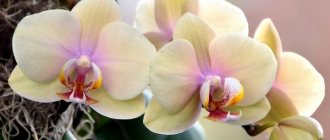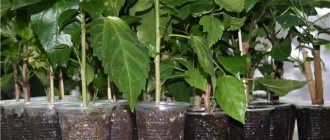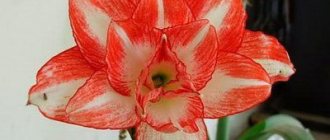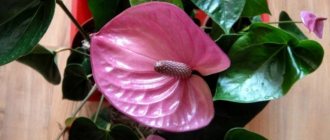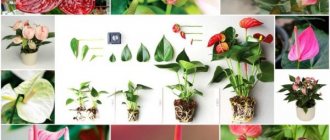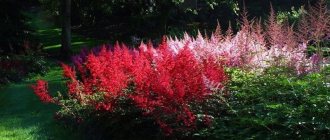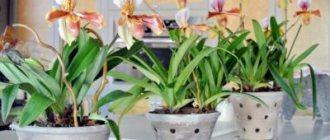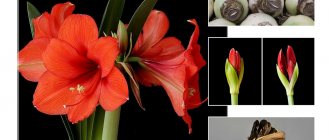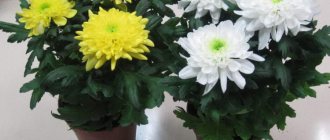Time and duration of flowering of anthurium at home
The main advantage of anthurium, because of which it is in demand in home floriculture, is its long flowering.
The formation of inflorescences begins in the second half of February, and the bush itself usually blooms for 4-5 weeks. However, if you care for it correctly and create conditions in the room that are close to tropical, that is, natural for anthurium, its flowering can last longer.
Anthurium - exotic flower
Important! Some varieties of anthurium tend to bloom for only a few hours.
“Male happiness” has blossomed. How does a plant need care?
If you become the owner of a flowering anthurium from a store, then your first desire is to transplant it into normal soil. But don't rush to do it right away. First of all, leave the plant for 1-2 weeks to get used to the new conditions. At this time, inspect the plant for hidden pests or diseases. If necessary, introduce quarantine for suspicious flowers, because it is easier to cure one newcomer than to process the entire collection later.
After 2 weeks from purchase, you can safely replant the plant. Almost all anthurium lovers advise replanting it by completely removing the old soil and washing the roots. If the bush is large enough and its age is more than 4 years, then at the same time you can divide the bush into several parts or carefully separate the children. Although it is better to do this before the anthurium blooms.
If you work carefully when transplanting a blooming anthurium, then the flowering will not be reflected in any way.
If you see rotten roots during transplantation, be sure to trim them to healthy tissue and sprinkle with crushed coal. A good stimulation and stress relief after such procedures will be soaking the roots for 20 minutes in the Kornevin solution and then spraying with Epin.
Soaking the roots for 20 minutes in a root solution will help survive replanting
If you got a very sick specimen and had to remove a lot of roots, then it is better to cut off the flower stalks and put them in water, and allow the plant to get stronger. In a vase with water, anthurium remains fresh for up to 2-3 weeks.
I wrote about how to properly transplant anthurium here.
For the first two months after transplanting into new soil, the anthurium is not fed, and then it is fertilized with a complex mineral fertilizer for flowering plants, where there will be a minimum of nitrogen. You should feed 1-2 times a month, diluting the recommended dose by 2 times. Overfeeding anthurium with nitrogen-containing fertilizers can lead to plant disease and the end of flowering.
Experienced anthurium growers recommend regular feeding of flowering plants with Orton Rost
Anthurium does not bloom, but produces only leaves: reasons
The main and most common reasons why anthurium does not bloom at home are improper care and unfavorable conditions for keeping the bush.
Pot too big
Why geraniums don’t bloom at home - what to do
For normal and healthy flower growth, soil rich in nutrients is required. Therefore, you should not plant a flower in a pot that is voluminous in relation to the diameter of the root system of the bush. It will be difficult for the bush to take all the vitamins and minerals from the soil, which is why it will stop producing buds and focus on the development of roots.
Errors in watering mode
One of the main reasons why anthurium does not bloom is irregular watering. It is important to water the flower every three days. Before retiring, the procedure is reduced to once a week, but this must be done gradually.
It is worth noting that low-quality watering liquid also affects the beautiful appearance of the bush. Often, due to hard tap water, diseases appear and the soil in the pot is depleted.
Important! You cannot water the bush with hot or cold water; it is better to bring it to room temperature.
Unsuitable temperature
For a tropical anthurium plant, a temperature ranging from 22 to 27 degrees is required. During the rest period, it should be gradually reduced to 18-20 degrees. You should also avoid sudden changes in the regime, otherwise it will become a lot of stress for the flower.
However, as the temperature rises, the air often stagnates indoors, and the bush begins to suffocate from stuffiness. Therefore, without airing the room, flowering may stop.
Insufficient humidity
The main rule for normal flowering of anthurium at home is to maintain high humidity in the room to create a tropical forest condition. Dry air not only leads to the inability to open buds, but also provokes the appearance of pests and drying of the leaves.
Deficiency or excess of essential microelements in the soil
If the anthurium does not bloom or grow, it means that the balance of nutrients in the soil has been disturbed. Lack or excess application of fertilizers to the soil negatively affects the normal growth of the bush.
Attention! It is very important to follow the dosage of complex mineral fertilizers indicated on the packaging.
Each mineral element is useful during a certain period of the growing season of the bush. For example, before the buds open, it is necessary to increase the nitrogen content in the soil, but after the formation of inflorescences, it is necessary to stop fertilizing the bush with such fertilizers. During this period, potassium-phosphorus preparations are needed. They are the ones who support the beautiful and abundant flowering of anthurium.
Drafts
When ventilating the bush to create a favorable temperature in the room, you should not overdo it. Strong drafts are another reason why anthurium stops blooming flowers.
When replanting a bush, do not damage the root system
Mistakes made during transplantation
Anthurium needs transplants, especially in the first years, when the root system is actively developing. However, the procedure must be carried out following certain rules.
- Firstly, you cannot use garden tools that have not been disinfected, as they may contain particles or juice of infected plants.
- Secondly, when planting the seedling itself, you need to protect the root system. Any mechanical damage, even a small scratch, can cause major problems with the flower in the future.
Note! If there are cuts left on the stems or roots, they must be treated with a solution of potassium permanganate or sprinkled with powdered activated carbon.
Diseases and parasites
The shrub rarely gets sick, but improper care often provokes the appearance of root rot or powdery mildew. The cause of rot is excessive watering, lack of loosening of the soil and poor-quality irrigation water.
Incorrect temperature
Another mistake in caring for anthurium is too high a temperature in winter: during the dormant period and during the period of bud formation. And in general, “male happiness” always prefers warmth, but not heat. If the temperature in winter is above 20 degrees, you may not expect flowering.
From the end of autumn, anthurium begins a dormant period lasting 2-3 months. The optimal temperature during this period is 15-17 degrees. Such cool conditions will contribute to the appearance of flower shoots in the future.
In mid-February, buds begin to form . At this time, the temperature should be raised to 18-20 degrees. If the apartment is more than 20 degrees in winter, the anthurium will not bloom. In summer, the optimal temperature for it is 20-25 degrees.
It is important to know that placing a flower pot in a draft also negatively affects the appearance of buds. Therefore, no to drafts, yes to flowers!
Other possible problems in anthurium flowering
Why cyclamen does not bloom at home and what to do
There are problems that do not appear immediately, but only after the anthurium blooms.
Flowers dry up and fall off
Blooming flowers can dry out for a number of reasons:
- a sharp increase in temperature in the room, causing the foliage to begin to dry out;
- incorrect balance of nutrients in the soil;
- improper pruning of the bush and untimely removal of faded buds;
- prolonged exposure to direct sunlight.
Greening of flowers or pistil
Changing the color of the pistil or the anthurium flower itself can be a natural process when flowering comes to an end. However, this behavior can also be provoked by poor lighting or an incorrect ratio of mineral elements in the fertilizer.
If the bush stops growing and does not bloom, the pot may have become cramped
Doesn't bloom or grow
The main reasons for stopping growth and flowering are a cramped pot and a lack of nutrients in the soil. If the root system grows, it begins to displace the soil and compact it. This provokes the inability of the bush to take up useful substances, which is why the plant simply stops developing.
Sometimes a bush stops growing due to insufficient lighting, since for any plant it is necessary to maintain the process of photosynthesis in a normal state.
Other reasons
Anthurium may not bloom if the air in the room where it is located is too dry.
To increase humidity, it is recommended to spray the plant with soft water at room temperature 1-2 times a day and wipe the leaves with a damp cloth from time to time.
Another reason for the lack of buds is an incorrectly selected substrate . Anthurium will not bloom if it grows in a substrate for bromeliads, for cacti, or in a peat mixture.
He needs soil that is very permeable to air and has a slightly acidic reaction. An ideal substrate for orchids.
A large number of already faded buds that remain on the stem may also be the reason that the anthurium does not bloom. The buds subsequently produce seeds, and this process weakens the plant as a whole. Therefore, after wilting, the flower shoots are carefully cut off with a sharp knife or scissors.
How to make anthurium bloom: tricks
Anthurium Andre - home care
If the anthurium has stopped blooming, what should you do after identifying the cause? First of all, take your time and approach the problem wisely.
Anthurium is a beautiful plant
Ready-made fertilizers
Feeding with ready-made complex mineral fertilizers, which were specially produced for anthuriums, will help make the bush bloom.
It is best to dissolve granular preparations in water and water the soil with it. Among dry fertilizers, “Forte”, “Fitosporin” and “Yantrain” help to bring the bush to normal condition.
Folk remedies
Even in the early stages of the problem, you can use traditional methods. You can make solutions for treating bushes at home, the main thing is to correctly calculate the proportions.
Flower growers resort to a little trick when the bush does not develop due to a disruption in the photosynthesis process. The formation of chlorophyll is disrupted due to a lack of lighting and iron, so you need to treat the soil with a solution of ferrous sulfate.
Note! If you spray the above-ground part of the bush with this solution, it will immediately visually take on a healthier appearance.
Anthurium is a flower with an amazingly beautiful appearance, the flowering of which is often suspended due to inattentive care. Therefore, you need to perform all activities regularly, following certain rules.
The purchased anthurium stopped blooming
Beginning lovers of tropical plants are often faced with the fact that the recently purchased anthurium, which was amazed by the abundance of flower stalks, has stopped blooming. At the same time, new foliage is not visible on the green pet. How to help the plant, improve its health and make the anthurium bloom again?
Such a specimen, first of all, needs to be replanted and allowed to gain strength. From industrial plantations to the shelves, most indoor plants come in shipping pots and a small amount of peat soil, generously flavored with fertilizers and chemicals. These products, the supply of which is designed for a couple of months, make indoor anthurium bloom. But neither the roots nor the above-ground part, which also supplies food, develops. If urgent measures are not taken, the plant becomes depleted and often dies.
After transplantation, the pet needs several months to strengthen and build up the root mass. If you maintain proper conditions, then in the spring the long-awaited flower stalks will appear on the anthurium.
Sometimes flower growers cannot wait for the flowering of young plants that previously did not please their owners with bright inflorescences. To provoke such indoor anthurium to form buds, you can use the methods used in greenhouses.
In late autumn or early winter, anthurium is placed in a room with a temperature of 16–20 °C. Such a room should be light, and if necessary, artificial lighting should not be abandoned. The plant needs regular watering, but not as much as in the summer months, when the air is noticeably warmer. The soil should be moist, but under no circumstances wet.
After 1.5–2 months, when the crown is replenished with new shoots, the anthurium is transferred to a warm place and watering is increased. The optimal temperature for this period is 22–24 °C. An anthurium that has not bloomed before will certainly produce its first flower stalk. And subsequent flowering, if you do not forget about proper care and comfort for the anthurium, will last about six or eight weeks.
What can I do to make Anthurium start growing?
Above, you read the reasons why Anthurium does not grow. To make it grow, you need to stop the one (or those) reasons that are suitable for your case.
If the Anthurium did not grow due to an incorrectly selected container or soil, then simply replant it taking into account the described tips.
If the reason was the wrong living environment, then do nothing with the plant itself, but simply change the conditions.
If you have not watered your plant correctly, I advise you to first check the root system for rot. If the roots are normal, then simply reconsider your watering system.
Be healthy!
Making anthurium bloom: difficult, but possible
The houseplant anthurium is attractive for its spectacular and original flowering.
Against the background of large bracts of scarlet, soft pink, purple or white, yellow flower cobs rise, and the rich green of the foliage contrasts their brightness. The shape of the inflorescences gave anthurium its second, popular name - “male happiness”. To admire the flowers, you need to carefully follow the rules for growing this capricious native of the South American continent. Knowing the reasons why sometimes anthurium does not bloom will help correct the situation, and amazingly attractive plants will decorate any room.
How to independently replant and propagate anthurium at home?
If you decide to transplant a flower into another pot, it is best to do this in the spring. At the same time, you can even replant an anthurium that has already bloomed at this time. Having taken out the plant along with a lump of earth on the roots, there is no need to remove this soil, but rather, along with it, the flower must be carefully moved into a new pot with fresh soil, which is a mixture of:
- rotted leaves;
- turf land;
- pieces of moss.
For growing “male happiness”, a not very deep, but rather wide pot is suitable, since the branched root system of the flower requires quite a lot of space. However, you should not choose a pot that is too large, following the principle that the bigger the better, as this may cause a complete absence of inflorescences on your anthurium. A layer of drainage should be placed at the bottom of the pot, since, as mentioned above, the roots of the plant do not like excessive moisture, which leads to their rotting and the death of the entire plant.
If you want to propagate “Male Happiness” yourself, this is done by dividing one bush into several parts (2-3). Taking into account the fact that after three years the plant begins to shed its leaves, it can and should be divided into parts at each transplant, in other words, annually. This way you will not only preserve the plant’s youth, but also multiply it. Thus, by properly caring for your anthurium, you will always have not only a very beautiful flower, but also, if it is properly propagated, gifts for the stronger half of humanity for all occasions. After all, not a single man has yet refused to receive “happiness” as a gift!
Flowering problems
“Male happiness” is a capricious flower. Even if flower stalks and buds appear on it, they may never open. Let's look at the main reasons for poor quality flowering.
Flowers are drying
If the flowers bloomed more than a month ago, then their drying is a biological process. New buds will be released to replace those that have bloomed, but if it is the young, and sometimes even unopened, buds that dry out, this indicates improper care.
Drying of flowers in the bud phase indicates too dry air
Drying of flowers and buds is primarily caused by insufficient humidity around the plant and lack of nutrition. If the anthurium’s soil dries out completely between waterings, and the room is very dry and hot, then it experiences stress, there is not enough moisture for the growing flowers, and they dry out. Subsequently, drying of the leaves and even death of the plant is possible.
Quite often, the flowers of anthuriums that stand on a south-facing, hot window dry out, even in a warm wind, and even more so in a draft.
When moving a flower from place to place, the flowers or leaves may also dry out.
Anthurium flowers turn green
Very often the color of anthurium flowers changes from bright to green. You shouldn’t be afraid of this - this is not a disease, just a natural cycle of the end of flowering. Usually green flowers are simply cut off. But if all the buds on the plant immediately begin to turn green, this may be a sign of a lack of nutrition when the anthurium completes its growing season and is preparing to rest.
In addition, varieties and hybrids have been bred in which the color of the bedspread has a greenish tint or coating.
Varieties of anthuriums with completely green bracts have been developed, for example, Midori
Green pestle
Most often, this is a feature of anthuriums of light and pastel colors, in particular, varieties Blush and pink Tennessee, which over time changes the color of the bedspread and cobs to green.
Pink anthurium of the Tennessi variety changes the color of the spadix and bract to green over time.
What to do, how to properly care for it
When purchasing an anthurium, you need to carefully study the information on caring for a tropical plant. In order to provide the flower with optimal conditions for growth and development, it is important to adhere to the following rules:
- Regular watering 2-3 times a week . In this case, there is no need to flood the plant, just moistening the earthen clod is enough.
- Providing air humidity of at least 60% . In winter, this figure can be achieved by using household humidifiers.
- The soil for anthurium should be soft, loose and permeable to moisture . You should not replant the plant into the ground from the street; you need to purchase a special substrate.
- If natural light does not last long enough, it is recommended to highlight male happiness additionally using lamps.
- You should not choose large pots. The new container for the flower should be only 1-2 cm larger than the previous one .
- When transplanting, you must determine the growth point . It should always remain on the surface.
- In summer, it is recommended to apply mineral fertilizers once every 2 weeks..
In order for the anthurium to continue to grow and bloom, you need to monitor the air temperature in the room. The optimal temperature is considered to be from +20 °C to +24 °C. It is also recommended to regularly inspect male happiness for pests or diseases that can destroy it.
Errors in watering
A stop in development can occur due to excessive watering, when the water in the pot is constantly in a swampy state. The roots will rot, which will disrupt the nutrition of the entire plant. The lack of flowering may also be due to a lack of moisture in the soil. As in other details, the flower loves the golden mean.
Moistening the soil should be done after the top layer has sufficiently dried. A large amount of water can be added at a time, but the procedure itself should be carried out infrequently.
Water requirements: soft, not cold, without calcium salts. When using tap water, it should be left in a glass container for 5 days before applying to the soil. If you use a filter, then settling is not required. The liquid should be acidified once every 7-14 days: 1-2 drops of lemon juice per liter.
Flowering time and plant photo
At home, anthuriums do not stop blooming almost all year round, from the beginning of February to the end of November, stopping only in the darkest and coldest months of winter. If you have a young anurium, then you should not worry about the lack of flowering, because with proper care, the anthurium begins to bloom in 2-3 years of life.
In the photo you can see how the anthurium blooms:
Little tricks to stimulate flowering
So, we have found out the main reasons for the lack of flowering of anthurium. But what to do if all the conditions are met: the pot is cramped, the soil is correct, the light is bright, diffused, watering is regular, the air humidity is high, the winter temperature was low? There is only one answer - stimulating flowering by creating a stressful situation. And pouring the earthen clod with hot water, heated to 40–50 degrees, helps with this. It is important to use this technique only once.
Fertilizers for anthurium
In nature, anthurium grows on the roots of trees and even on branches, so it takes all its nutrition from moist air. Therefore, many gardeners also do not feed their anthuriums, but make up for the lack of nutrients with good soil and frequent replanting.
It is better to use liquid fertilizer diluted 2 times for flowering plants that contain less nitrogen than phosphorus and potassium. That is, if the package says to dilute a cap of fertilizer in a liter of water, then for anthurium you dilute the same cap in two liters of water.
To stimulate flowering, you can periodically spray with a solution of Epin, Bud or Ovary.
For long-term flowering, you can spray the inside with Bud solution, starting in February
And after transplanting, water with Kornevin or Zircon.
The feeding regime is no more than 2 times a month and only on moist soil and under conditions of good lighting and sufficient heat, otherwise you can burn the roots of the plant.
